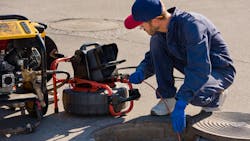What to know about sewer inspection and cleaning
Regularly inspecting cleaning sewers is essential for the proper functioning of a wastewater collection system. What do sewer inspections and sewer cleanings look like for most utilities?
Routine inspection helps to minimize the risk of more serious problems, like sewer backups and overflows. Most inspections are part of a routine maintenance program, though some operations are in response to unexpected blockages. These help to identify potential blockages and to monitor the structural health of pipes.
Cleanings help to prevent or resolve the buildup of any materials that can obstruct the sewer’s flow. Stoppages, caused by obstructions such as roots, grease, debris, or broken pipe, can interrupt this flow. These interruptions can raise the risk of sewer overflows, threatening property and human health.
There are countless approaches a utility can take in inspection frequency, cleaning frequency, and equipment used. Each aspect depends on a variety of factors. For example, the equipment available to the utility, the services a utility can afford, and the availability of trained workers can all affect what approach a utility can take in inspecting or cleaning a section sewer.
How do you inspect a sewer system?
“Sewer inspection is all about asset management and providing those fundamentals of providing this level of service, managing risks and minimizing costs,” said Daniel Buonadonna, senior technology leader at Jacobs. “And in order to do that, that depends on having good information about the condition of your system.”
Sewer inspections are most often part of a broader, continuous collection system inspection program. This program goes beyond sewer pipes, utilizing lift station inspections, dyed water testing, and more. This program ensures inspections occur at regularly scheduled intervals.
How often each portion of pipe should be inspected, however, can depend on many factors.
“Leveraging the smart systems that the industry has today is really going to be seen as the best practice in terms of recommendation, especially for larger networks,” said Buonadonna. “What that means is some pipes need to be inspected more frequently than others based on the risk they present to the system.”
For example, smaller pipes can often need cleaning more often than larger pipes. Historic problems with root penetration or grease accumulation can require more frequent cleaning or inspections.
“Certain areas that are prone with grease are anywhere where you have a lot of restaurants or you get in neighborhoods where people cook with a lot of grease,” said Dan Story, general sales manager at KEG Technologies. “Grease is a major issue for sewers all across the United States. Other issues are rags, flushable wipes or roots. Roots come from trees. If you're in a drought area, the more drought area you have, the more you're going to find roots in your sewer system. And you need to keep your roots out because that grabs the material and starts the blockage as it builds up over time. Then it completely blocks the line.”
It can also be important to inspect some pipe sections more often when they are critical to the functioning of the collection system.
Inspection for blockages has traditionally involved manhole inspections, sewer lamping, or television inspection. New technologies are also allowing for more affordable, less invasive inspections, such as those via pipe penetrating radar systems.
The available solutions for inspections are wide, with as many different approaches as there are sewer characteristics.
“There are different technologies for different phases of a condition assessment effort and they really can be grouped into screening level technologies, characterization level technologies, and then predesigned or pre rehabilitation technologies,” said Buonadonna. “So the idea is that each one of these main three groups has different price points.”
For screening level technologies, according to Buonadonna, some of the technologies are low in cost but provide only broad network analysis. Technologies in the middle range might provide a greater wealth of more precise information, but can come at a higher cost. The pre-rehabilitation technologies can provide very specific information at a significant cost, and are often only needed for involved, concentrated projects like rehabilitation.
“The industry currently enjoys dozens, if not maybe over 100 different technologies that can fit into each one of these buckets and address each one of these aspects,” said Buonadonna.
The most conventional technology for gravity sewers is closed-circuit television (CCTV) inspection. Under that approach, CCTV cameras are mounted on machines that can crawl through a section of pipe, recording visual data of the inside of the pipe.
However, even CCTV inspection data can become part of a wide range of smart utility solutions.
“But what we're seeing grow exponentially is better ways of processing that data and combining it with these newer, smart systems, different smart sensors or even artificial intelligence so that each mile of that inspection information can go even further from the network,” said Buonadonna.
What is the purpose of a sewer inspection camera?
A CCTV inspection is valuable for identifying possible issues in a section of sewer pipe, as well as for analyzing trends.
The immediate visual data of a camera inspection can help to quickly identify potential blockages. In addition, the data can help establish priorities in regular maintenance operations. It can even inform plans for sewer rehabilitations.
These camera inspections offer much more data than utilities can afford to process through human labor alone, however. With the rise of sophisticated data management, like artificial intelligence (AI), the uses for this data are growing.
“One of the one of the big growth areas that we're seeing is the introduction of AI into the sewer industry,” said Buonadonna. “There's a lot of data that is being collected by these cameras. That's a very time consuming process to convert that data over into information that utilities can use. And so we're seeing artificial intelligence really being a big benefit; it can ingest that raw data comes from the cameras and process that information into something that engineers can use to prioritize and make decisions about which pipes need to be fixed, where, when and how much will it cost.”
How to clean sewer systems
Sewer cleaning is both a regularly scheduled operation and a solution for blockages.
Most sewer cleaning can be split into three broad categories: hydraulic cleaning, mechanical cleaning, and chemical cleaning.
Hydraulic sewer cleaning
With hydraulic cleaning, high-pressure water can wash grit, grease and debris down the sewer, clearing away potential blockages. This category includes jetting, one of the most common solutions for gravity sewer cleaning today. It also includes balling and flushing.
Mechanical cleaning for sewers
Mechanical cleaning uses equipment that directly dislodges blockages and debris, either through powered equipment or by hand. These tools can pull, push, cut or scrape blocking material. This approach can be effective for stubborn blockages like those caused by roots. It can include scrapers, bucket machines, power rodders, and hand rods.
For example, cutting can be useful for large, dense balls of roots.
“You want to go in with a type of a small blade cutter, maybe a chain flail type cutter, something that's turning chains and high RPMs, high torque so that it doesn't stall a cutter out and it will go to an open net flight back up,” said Story. “Not only that, but mineral deposits, calcium deposits are also done with similar methods of high speed, high torque chain coils to cut that out.”
Chemical sewer cleaning
Chemical cleaning uses specialized chemicals to approach particular problems. It can be a useful solution when applied with care. For example, the herbicide 2,6 dichlorobenzonitrile can kill roots in hard-to-reach locations. This approach should be taken only with direct intent, and the chemicals used should be approved by local governments.
Problematic sections prone to blockages will generally need more cleaning. Cleaning can also be necessary before and after pipe rehabilitation.
Records are essential
It is important to remember that there can be as many different technologies and solutions as there are types of sewers. However, wise utility management principles apply for every wastewater system.
It is always important to maintain an accessible, centralized record of inspections and cleanings throughout a sewer system. Strong record-keeping helps to develop an efficient maintenance program or to identify problematic sections of pipe. It can also help the utility to better manage staff time by anticipating problems and predicting likely solutions.
About the Author

Jeremy Wolfe
Jeremy Wolfe is a former Editor for Wastewater Digest.
